#Milk Processing Plant Manufacturers
Explore tagged Tumblr posts
Text
https://www.pranamjiengineering.com/how-to-start-a-dairy-business-in-india/
How to Start a Dairy Business in India The dairy business in India is one of the most lucrative and sustainable, owing to the country’s massive demand for milk and dairy products. Starting a dairy business involves strategic planning, the right infrastructure, and adherence to industry regulations. Read more: https://www.pranamjiengineering.com/
0 notes
Text
#Milk Processing Plant Manufacturers#Milk Processing Plant Suppliers#Milk Processing Plant Exporters
0 notes
Text
Mawa Machine Manufacturers | Khoya Machine Manufacturers
Mahavir Industries is a renowned name in the market of Mawa Machine Manufacturers. Our machines are made from high-grade stainless steel, which ensures durability and long-lasting performance. We also offer machines made from other materials such as mild steel and aluminum, based on the specific needs of our customers. Our mawa machines come in various sizes to cater to the production requirements of different industries. We offer small machines for home-based businesses as well as large machines for commercial setups. Also, the machines are designed to produce high-quality mawa/khoya consistently, with minimal maintenance and easy operation. We use advanced technology in our machines to ensure energy efficiency and low operating costs.

#Mawa Machine Manufacturers#Paneer Plant Manufacturers#Khoya Machine Manufacturers#Milk Processing Plant Manufacturers#Mini Milk Plant Manufacturers#Ghee Plant Manufacturers
0 notes
Text
0 notes
Text
Milk processing plant manufacturer in India
We “Saffron Machinery” have gained success in the Milk processing plant manufacturer in Indian market by Manufacturing and Exporting a remarkable gamut of Dairy Machinery, Milk And Dairy Plant, Milk Storage Tank, Juice Processing Plant, Industrial Chiller, Ice-Cream Processing Machinery And Plant, CIP System, Bulk Milk Cooler, Mango Processing Plant, Fruit & Vegetable Processing Plant, Cold Room, etc. We are a well-known and reliable company at Ahmedabad (Gujarat, India). Our offered products are manufactured in compliance with the pre-defined industry norms and tested to ensure their flawlessness. Our Mission is To discover, deploy, develop and direct the available resources to enable them to demonstrate their optimum capacities to attain the highest possible level of productivity, profitability and customer satisfaction. Providing self employment in Rural India thereby improving their standard of living. We also Offering Industrial Erection Service to Our Client.
Incorporated in 2016 as Saffron Machinery with State-of-the-art Manufacturing unit of Dairy Equvipment, Food Processing Plants, Industrial Chillers And Amonia Chilling Plants,cold Rooms.
Highly skilled, dedicated, experienced work force.
0 notes
Text
Fast and High-Quality Dairy Product Production with Mini Dairy Plant Machinery and Equipment
Efficient and high-quality production is essential in the ever-changing dairy industry. To keep up with the rising demand for high-quality, freshly-dairy products, small and medium-sized dairy companies require dependable, high-performance solutions. Milk Processing Plant and Machines for micro dairy plants come into play here, allowing for rapid, scalable, and high-quality milk production.

#Milk Processing Plant and Machines#Milk Processing Plant and Machines Manufacturers#Milk Processing Plant and Machines Suppliers#Milk Machines#Milk Processing Machines#Milk#Dairy Equipment#Dairy Machines#Dairy Machine Manufacturers
0 notes
Text
Saffron Machinery is a leading dairy plant and equipment manufacturer in India, specializing in milk processing plant solutions. Our extensive range includes dairy machinery, milk storage tanks, juice processing plants, and industrial chillers, all designed to meet the highest industry standards. Based in Ahmedabad, Gujarat, we are committed to delivering reliable and efficient products that enhance productivity and profitability. Our mission focuses on optimizing resources while promoting self-employment in rural India, thereby improving living standards. Additionally, we provide industrial erection services, ensuring comprehensive support for our clients in the dairy and food processing sectors.
1 note
·
View note
Text
How Does Milk Processing Plant work and Its Benefits?
A Milk Processing Plant is a facility that transforms raw milk into a variety of dairy products, such as cheese, butter, yogurt, and packaged milk. The plant employs several processes to ensure the milk is safe, nutritious, and of high quality.

Milk Processing Plant
1. Receiving and Storage: Raw milk is received from dairy farms and stored in refrigerated silos or tanks.
2. Pre-Treatment: Milk is pre-treated to remove dirt, sediment, and other impurities through centrifugation, filtration, or cream separation.
3. Pasteurization: Milk is heated to kill off bacteria and extend shelf life.
4. Standardization: Milk is standardized to achieve the desired fat content and composition.
5. Homogenization: Milk is forced through a small opening to break down fat molecules, ensuring uniform consistency.
6. Cooling and Packaging: Processed milk is cooled and packaged in various formats.
7. Quality Control and Distribution: Final products undergo quality control checks before distribution.
Benefits
1. Ensures Food Safety: Pasteurization and quality control measures eliminate harmful bacteria, ensuring safe consumption.
2. Extends Shelf Life: Processing allows milk to be stored and transported over longer periods without spoilage.
3. Consistent Quality: Standardization and homogenization ensure consistent taste, texture, and nutritional content.
4. Variety of Products: Plants can produce a range of dairy products, catering to diverse consumer needs.
5. Supports Local Dairy Farmers: Processing plants provide a market for local dairy farmers, contributing to the local economy.
6. Efficient Distribution: Plants can distribute products to a wider audience, making dairy products more accessible.
7. Nutritional Value: Processing helps retain essential nutrients, like calcium and protein, in milk products.
For More Information –
Contact us – +91-9560336670
Email Id – [email protected]
Address - Plot No. 14 F, Gali No. 2, Rajendra Nagar Industrial Area Mohan Nagar Ghaziabad - 201005, Uttar Pradesh, India
#milk processing plant#milk processing plant manufacturer#milk processing plant supplier#milk processing plant in india
0 notes
Text
Milton Orr looked across the rolling hills in northeast Tennessee. “I remember when we had over 1,000 dairy farms in this county. Now we have less than 40,” Orr, an agriculture adviser for Greene County, Tennessee, told me with a tinge of sadness.
That was six years ago. Today, only 14 dairy farms remain in Greene County, and there are only 125 dairy farms in all of Tennessee. Across the country, the dairy industry is seeing the same trend: In 1970, more than 648,000 US dairy farms milked cattle. By 2022, only 24,470 dairy farms were in operation.
While the number of dairy farms has fallen, the average herd size—the number of cows per farm—has been rising. Today, more than 60 percent of all milk production occurs on farms with more than 2,500 cows.
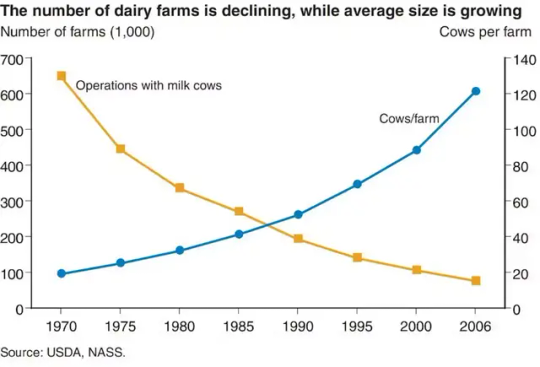
This massive consolidation in dairy farming has an impact on rural communities. It also makes it more difficult for consumers to know where their food comes from and how it’s produced.
As a dairy specialist at the University of Tennessee, I’m constantly asked: Why are dairies going out of business? Well, like our friends’ Facebook relationship status, it’s complicated.
The Problem with Pricing
The biggest complication is how dairy farmers are paid for the products they produce.
In 1937, the Federal Milk Marketing Orders, or FMMO, were established under the Agricultural Marketing Agreement Act. The purpose of these orders was to set a monthly, uniform minimum price for milk based on its end use and to ensure that farmers were paid accurately and in a timely manner.
Farmers were paid based on how the milk they harvested was used, and that’s still how it works today.
Does it become bottled milk? That’s Class 1 price. Yogurt? Class 2 price. Cheddar cheese? Class 3 price. Butter or powdered dry milk? Class 4. Traditionally, Class 1 receives the highest price.
There are 11 FMMOs that divide up the country. The Florida, Southeast, and Appalachian FMMOs focus heavily on Class 1, or bottled, milk. The other FMMOs, such as Upper Midwest and Pacific Northwest, have more manufactured products such as cheese and butter.
For the past several decades, farmers have generally received the minimum price. Improvements in milk quality, milk production, transportation, refrigeration, and processing all led to greater quantities of milk, greater shelf life, and greater access to products across the US. Growing supply reduced competition among processing plants and reduced overall prices.
Along with these improvements in production came increased costs of production, such as cattle feed, farm labor, veterinary care, fuel, and equipment costs.
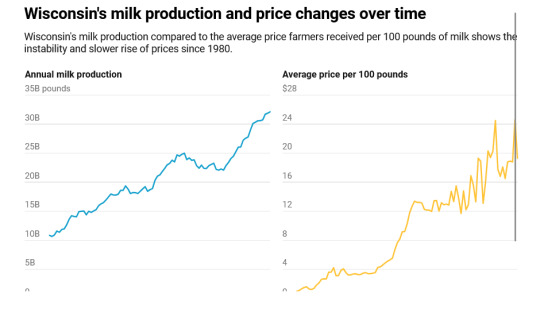
Researchers at the University of Tennessee in 2022 compared the price received for milk across regions against the primary costs of production: feed and labor. The results show why farms are struggling.
From 2005 to 2020, milk sales income per 100 pounds of milk produced ranged from $11.54 to $29.80, with an average price of $18.57. For that same period, the total costs to produce 100 pounds of milk ranged from $11.27 to $43.88, with an average cost of $25.80.
On average, that meant a single cow that produced 24,000 pounds of milk brought in about $4,457. Yet, it cost $6,192 to produce that milk, meaning a loss for the dairy farmer.
More efficient farms are able to reduce their costs of production by improving cow health, reproductive performance, and feed-to-milk conversion ratios. Larger farms or groups of farmers—cooperatives such as Dairy Farmers of America—may also be able to take advantage of forward contracting on grain and future milk prices. Investments in precision technologies such as robotic milking systems, rotary parlors, and wearable health and reproductive technologies can help reduce labor costs across farms.
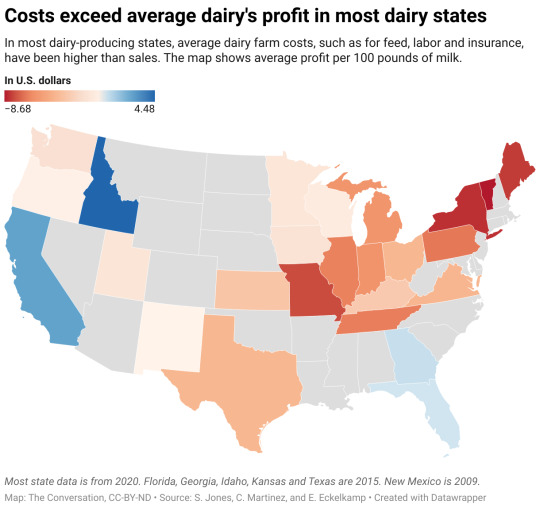
Regardless of size, surviving in the dairy industry takes passion, dedication, and careful business management.
Some regions have had greater losses than others, which largely ties back to how farmers are paid, meaning the classes of milk, and the rising costs of production in their area. There are some insurance and hedging programs that can help farmers offset high costs of production or unexpected drops in price. If farmers take advantage of them, data shows they can functions as a safety net, but they don’t fix the underlying problem of costs exceeding income.
Passing the Torch to Future Farmers
Why do some dairy farmers still persist, despite low milk prices and high costs of production?
For many farmers, the answer is because it is a family business and a part of their heritage. Ninety-seven percent of US dairy farms are family owned and operated.
Some have grown large to survive. For many others, transitioning to the next generation is a major hurdle.
The average age of all farmers in the 2022 Census of Agriculture was 58.1. Only 9 percent were considered “young farmers,” age 34 or younger. These trends are also reflected in the dairy world. Yet, only 53 percent of all producers said they were actively engaged in estate or succession planning, meaning they had at least identified a successor.
How to Help Family Dairy Farms Thrive
In theory, buying more dairy would drive up the market value of those products and influence the price producers receive for their milk. Society has actually done that. Dairy consumption has never been higher. But the way people consume dairy has changed.
Americans eat a lot, and I mean a lot, of cheese. We also consume a good amount of ice cream, yogurt, and butter, but not as much milk as we used to.
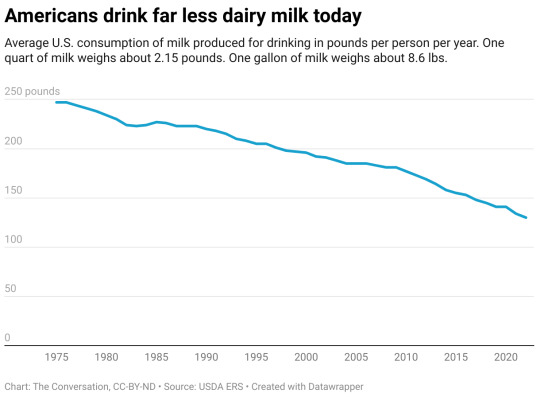
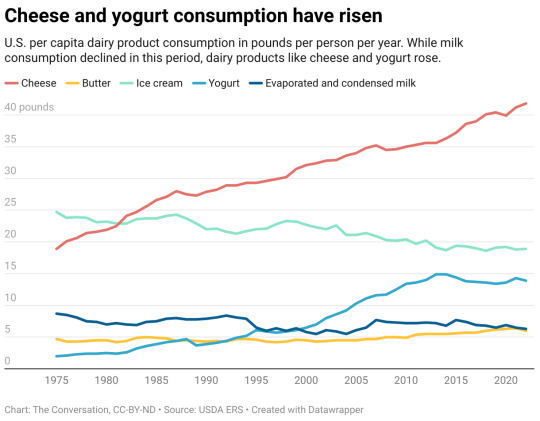
Does this mean the US should change the way milk is priced? Maybe.
The FMMO is currently undergoing reform, which may help stem the tide of dairy farmers exiting. The reform focuses on being more reflective of modern cows’ ability to produce greater fat and protein amounts; updating the cost support processors receive for cheese, butter, nonfat dry milk, and dried whey; and updating the way Class 1 is valued, among other changes. In theory, these changes would put milk pricing in line with the cost of production across the country.
The US Department of Agriculture is also providing support for four Dairy Business Innovation Initiatives to help dairy farmers find ways to keep their operations going for future generations through grants, research support, and technical assistance.
Another way to boost local dairies is to buy directly from a farmer. Value-added or farmstead dairy operations that make and sell milk and products such as cheese straight to customers have been growing. These operations come with financial risks for the farmer, however. Being responsible for milking, processing, and marketing your milk takes the already big job of milk production and adds two more jobs on top of it. And customers have to be financially able to pay a higher price for the product and be willing to travel to get it.
33 notes
·
View notes
Text
A Guided Tour of the Fortress Blizzardpaddles

Starting from the top of the fortress, I have a mist generator on the roof

Above the entrance I have a public tavern and a small library. Archer towers surround my fort, though they've never been put to use.

Before the archer towers, I build this platform for my archers. Also never used. The platform in the center was originally just meant to keep snow and rain from falling into the fortress.

At ground level, we have corpse and refuse stockpiles, beehives, nest boxes, and a garden.

On the main floor, we have the trade depot right at the entrance. I separate my trade goods into two stockpiles: one for elves, and one for everyone else. I recently overhauled my military and relocated some of the barracks and archery ranges. at the south is my fishery, which is protected with iron grates in the river and glass blocks above. I'm not sure why but I have perpetual ice in the river. To the east are some new farms I'm building to scale up my dye and cloth production. I also have my surface hospital here, seed storage, and a mist generator.

Below I have archery ranges, soap making, my citizen's/residents tavern (recently rearranged) milling and pressing, farms, and farmer workshops. I'm proud of that tower sticking up out of the water. The river here freezes from mid-autumn to early spring but it was a race against the clock to get that watertight.

Here I have food & Drink storage for the tavern above. I also have a large library with hundreds of written works. Beneath the soapmakers workshops is a stockpile of lye, oil, and tallow. Below the farmers workshops is a stockpile for wool, milk, and processable plants.

Food and drink production, including butchers, ashery (supplying lye upwards), stills, and kitchens.

Storage and supplies for food & drink production, and block & brick storage. meltable objects are above the smelters for recycling.

Manufacturing level. I try to keep workshops grouped by supply chain, with stockpiles above and below in a way that makes sense. See below for an example.

Wood feeds the carpenters and the wood furnace. Fuel is near all the furnaces, kilns, and forges. Textile industry is grouped together. This requires quite a bit of planning, and learning from experience from previous forts.

TEMPLES! I started making quadruple-size temples for the faiths with ~100 followers, because the smaller ones were getting very crowded. Every temple has a bunch of instruments, and almost all of them have a dedicated performer. The large temples are built with steel block walls.

Nobles apartments, and museum.

Guildhalls. I'm starting to build more even if the guilds aren't established yet. As my economy grows more complex, there are a lot more job titles, so there are fewer guilds being established.

Residential quarter. This is my first time giving everyone a 4x4 bedroom. I used to do 1x3 bedrooms, which allowed me to fit 12 rooms per block. I think the dwarves prefer the extra space though. I spent several years renovating the bedrooms by replacing stone walls with porcelain brick, and they LOVE it!

Tombs. Too many tombs. Most of them are full, a lot of them are pets though. My dungeons is here, with my Cask of Amontillado'd werelizard in the northeast corner.

And finally, several layers below, is my cavern hospital. It's really nice to have a second hospital down below for when the Amphibian Folk come and fuck with us.
That's all for this fort. My FPS hovers between 8 and 15 so it takes about 15 hours to go through a single year. I don't want to be done with it, but it's getting unbearably slow.
26 notes
·
View notes
Text

In the United States, 1 out of 37 children are now born with Autism. In the last 20 years the rate of babies born with birth defects has doubled. Gender Dysphoria rates are staggering.
Factory farmed livestock are given synthetic estrogens in their feed such as "Revular", used to make the animals gain weight faster, these synthetic estrogens are ending up in the waterways, the animal waste is also used as fertilizer along with human biowaste from treatment plants for food crops. The majority of contamination areas are in agricultural regions which correlate with the biggest rise in birth defects, Autism and Gender Dysphoria.
The "corn" that is added to animal feed is the byproduct from ethanol refining and corn oil refining and the Rapeseed from canola oil refining, same with soy, all of which are also GMO'S. Seed oils, corn, canola, vegetable and (palm oil), are extracted using the endocrine disruptor and toxin, Hexane. PFAS, Phthalates (Phthalates are a group of chemicals used to make plastics more durable. They are often called plasticizers) are now found in nearly all human blood and breast milk.
Endocrine Disrupting chemicals have been associated with Gender Dysphoria and Autism, Autoimmune diseases, low testosterone, birth defects, and low fertility rates. There are also related to mental health conditions.
All of the synthetic petroleum based bioengineered chemicals are toxins that are recycled by the liver back into the blood stream and stored in the bones. These are forever chemicals that are accumulative in both human and animal bodies. These chemicals are in municipal tap water, meat, dairy and every processed food.
Flouride as hydrofluorosilic and hexafluorosilic acid, which are byproducts from the phosphate fertilizer and aluminum manufacturing industries are added to treat municipal water as cheap substitutes for sodium flouride, and are also used in the manufacturing of pesticides and fungicides. 90% of chronic illness and all autoimmune diseases are related to toxic processed chemical laden food.
28 notes
·
View notes
Text
Uses of Milk Processing Plant for Dairy Farm
Milk processing plants are essential for dairy farms as they transform raw milk into a variety of consumer-ready products like cheese, yogurt, and butter, significantly increasing profitability. These facilities extend the shelf life of milk through pasteurization and ensure high quality and safety standards, which are crucial for consumer trust. By processing milk, dairy farms can reach broader markets, enhance product nutritional value, and effectively manage waste by repurposing by-products. Additionally, modern automation improves efficiency, allowing farms to scale operations while complying with regulatory standards. Ultimately, investing in a milk processing plant supports local economies and fosters brand development, enabling dairy farms to thrive in a competitive market.
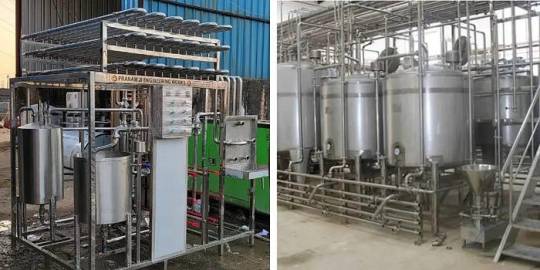
What is a Milk Processing Plant?
A milk processing plant is a facility designed to handle, process, and package milk and dairy products. These plants employ various technologies and equipment to ensure the milk is pasteurized, homogenized, and packaged safely for consumption.
Types of Milk Processing Plants
Milk processing plants come in various capacities to cater to different production needs. Here’s a breakdown of common sizes and their associated costs:
100 Ltr Milk Processing Plant Cost: Ideal for small dairies or startups, this capacity is suitable for local markets and specialty products.
200 Ltr Milk Processing Plant Cost: Slightly larger, this plant can serve small businesses looking to scale up their production.
300 Ltr Milk Processing Plant Cost: Perfect for growing operations that need more flexibility in their product range.
500 Ltr Milk Processing Plant Cost: A mid-sized option that balances capacity with space requirements, suitable for small to medium-sized dairies.
1000 Ltr Milk Processing Plant Cost: This size is often used by medium enterprises aiming for higher production volumes.
5000 Ltr Milk Processing Plant Cost: Designed for larger operations, this capacity allows for extensive processing and product diversity.
10000 Ltr Milk Processing Plant Cost: Perfect for large-scale dairy operations that require significant output to meet market demands.
2000 Ltr Milk Processing Plant Cost: A popular choice for businesses looking to expand their production capabilities without going to the maximum scale.
Choosing a Right Milk Processing Plant Manufacturer
When selecting a milk processing plant manufacturer, it’s crucial to consider several factors:
Experience and Reputation: Look for manufacturers with a proven track record in the industry. Research reviews and testimonials to gauge their reliability.
Quality of Equipment: Ensure the manufacturer uses high-quality materials and adheres to industry standards for hygiene and safety.
Customization Options: A good manufacturer should be able to provide tailored solutions that meet your specific needs and production goals.
After-Sales Support: Check if the manufacturer offers installation, training, and maintenance support to keep your plant running smoothly.
Cost Efficiency: Compare prices among different milk processing plant manufacturers to find the best balance between quality and cost.
If you are looking for Best Milk Processing Plant Manufacturer in India, look no further than Pranamji Engineering Works, we are a leading Milk Processing plant manufacturer, supplier and exporter in India.
Conclusion
Investing in a milk processing plant can significantly enhance your business’s capacity to meet the growing demand for dairy products. Understanding the various sizes and their respective costs — ranging from the 100 ltr milk processing plant cost to the 10000 ltr milk processing plant cost — will help you make informed decisions.
By partnering with a reputable milk processing plant manufacturer, you can ensure your operation is efficient, compliant, and capable of producing high-quality dairy products. Whether you’re starting small with a 500 ltr milk processing plant or going big with a 5000 ltr milk processing plant, the right investment will pay off in the long run.
For more details, please contact us!
Website :- www.pranamjiengineering.com
Contact No. :- 09997737365, 7017598033
Email :- [email protected]
Address :- Khasra No 346, Jalapur, Raghunathpur Muradnagar, Ghaziabad Uttar Pradesh — 201206
#Milk Processing Plant#Milk Processing Plant manufacturer#Milk Processing Plant supplier#Milk Processing Plant manufacturer in India#Milk Processing Plant supplier in India#pranamji engineering works
1 note
·
View note
Text
Milk Processing Plant Manufacturers in Pune
Milk Processing Plant Manufacturers/Suppliers/Exporters in Pune
#Milk Processing Plant Manufacturers#Milk Processing Plant Suppliers#Milk Processing Plant Exporters
0 notes
Photo

One of the leading Milk Processing Plant Manufacturers in India is Mahavir Industries. We are known for our finest machine plants and after-sale services. our machines are built to last to withstand every wear and tear.
0 notes
Text

A list of animal ingredients and their alternatives helps consumers avoid animal ingredients in food, cosmetics, and other products.
By the Nazarene Way.
There are thousands of technical and patented names for ingredient variations. Furthermore, many ingredients known by one name can be of animal, vegetable, or synthetic origin. If you have a question regarding an ingredient in a product, call the manufacturer. Good sources of additional information are the Consumer's Dictionary of Cosmetic Ingredients, the Consumer's Dictionary of Food Additives, or an unabridged dictionary. All of these are available at most libraries.
Adding to the confusion over whether or not an ingredient is of animal origin is the fact that many companies have removed the word "animal" from their ingredient labels to avoid putting off consumers. For example, rather than use the term "hydrolyzed animal protein," companies may use another term such as "hydrolyzed collagen." Simple for them, but frustrating for the caring consumer.
Animal ingredients are used not because they are better than vegetable-derived or synthetic ingredients but rather because they are generally cheaper. Today's slaughterhouses must dispose of the byproducts of the slaughter of billions of animals every year and have found an easy and profitable solution in selling them to food and cosmetics manufacturers.
Animal ingredients come from every industry that uses animals: meat, fur, wool, dairy, egg, and fishing, as well as industries such as horse racing and rodeo, which send unwanted animals to slaughter.
Rendering plants process the bodies of millions of tons of dead animals every year, transforming decaying flesh and bones into profitable animal ingredients. The primary source of rendered animals is slaughterhouses, which provide the "inedible" parts of all animals killed for food. The bodies of companion animals who are euthanized in animal shelters wind up at rendering plants, too. One small plant in Quebec renders 10 tons of dogs and cats a week, a sobering reminder of the horrible dog and cat overpopulation problem with which shelters must cope.
Some animal ingredients do not wind up in the final product but are used in the manufacturing process. For example, in the production of some refined sugars, bone char is used to whiten the sugar; in some wines and beers, isinglass (from the swim bladders of fish) is used as a "clearing" agent.
Kosher symbols and markings also add to the confusion and are not reliable indicators on which vegans or vegetarians should base their purchasing decisions. This issue is complex, but the "K" or "Kosher" symbols basically mean that the food manufacturing process was overseen by a rabbi, who theoretically ensures that it meets Hebrew dietary laws. The food also may not contain both dairy products and meat, but it may contain one or the other. "P" or "Parve" means the product contains no meat or dairy products but may contain fish or eggs. "D," as in "Kosher D," means that the product either contains dairy or was made with dairy machinery. For example, a chocolate and peanut candy may be marked "Kosher D" even if it doesn't contain dairy because the non-dairy chocolate was manufactured on machinery that also made milk chocolate. For questions regarding other symbols, please contact the Orthodox Union (212-563-4000) or other Jewish organizations or publications.
Thousands of products on store shelves have labels that are hard to decipher. It's nearly impossible to be perfectly vegan, but it's getting easier to avoid products with animal ingredients. Our list will give you a good working knowledge of the most common animal-derived ingredients and their alternatives, allowing you to make deci-sions that will save animals' lives.
Adrenaline. Hormone from adrenal glands of hogs, cattle, and sheep. In medicine. Alternatives: synthetics.
Alanine. (See Amino Acids.)
Albumen. In eggs, milk, muscles, blood, and many vegetable tissues and fluids. In cosmetics, albumen is usually derived from egg whites and used as a coagulating agent. May cause allergic reaction. In cakes, cookies, candies, etc. Egg whites sometimes used in "clearing" wines. Derivative: Albumin.
Albumin. (See Albumen.)
Alcloxa. (See Allantoin.)
Aldioxa. (See Allantoin.)
Aliphatic Alcohol. (See Lanolin and Vitamin A.)
Allantoin. Uric acid from cows, most mammals. Also in many plants (especially comfrey). In cosmetics (especially creams and lotions) and used in treatment of wounds and ulcers. Derivatives: Alcloxa, Aldioxa. Alternatives: extract of comfrey root, synthetics.
Alligator Skin. (See Leather.)
Alpha-Hydroxy Acids. Any one of several acids used as an exfoliant and in anti-wrinkle products. Lactic acid may be animal-derived (see Lactic Acid). Alternatives: glycolic acid, citric acid, and salicylic acid are plant- or fruit-derived.
Ambergris. From whale intestines. Used as a fixative in making perfumes and as a flavoring in foods and beverages. Alternatives: synthetic or vegetable fixatives.
Amino Acids. The building blocks of protein in all animals and plants. In cosmetics, vitamins, supplements, shampoos, etc. Alternatives: synthetics, plant sources.
Aminosuccinate Acid. (See Aspartic Acid.)
Angora. Hair from the Angora rabbit or goat. Used in clothing. Alternatives: synthetic fibers.
Animal Fats and Oils. In foods, cosmetics, etc. Highly allergenic. Alternatives: olive oil, wheat germ oil, coconut oil, flaxseed oil, almond oil, safflower oil, etc.
Animal Hair. In some blankets, mattresses, brushes, furniture, etc. Alternatives: vegetable and synthetic fibers.
Arachidonic Acid. A liquid unsaturated fatty acid that is found in liver, brain, glands, and fat of animals and humans. Generally isolated from animal liver. Used in companion animal food for nutrition and in skin creams and lotions to soothe eczema and rashes. Alternatives: synthetics, aloe vera, tea tree oil, calendula ointment.
Arachidyl Proprionate. A wax that can be from animal fat. Alternatives: peanut or vegetable oil.
Aspartic Acid. Aminosuccinate Acid. Can be animal or plant source (e.g., molasses). Sometimes synthesized for commercial purposes.
Bee Pollen. Microsporic grains in seed plants gathered by bees then collected from the legs of bees. Causes allergic reactions in some people. In nutritional supplements, shampoos, toothpastes, deodorants. Alternatives: synthetics, plant amino acids, pollen collected from plants.
Bee Products. Produced by bees for their own use. Bees are selectively bred. Culled bees are killed. A cheap sugar is substituted for their stolen honey. Millions die as a result. Their legs are often torn off by pollen-collection trapdoors.
Beeswax. Honeycomb. Wax obtained from melting honeycomb with boiling water, straining it, and cooling it. From virgin bees. Very cheap and widely used but harmful to the skin. In lipsticks and many other cosmetics (especially face creams, lotions, mascara, eye creams and shadows, face makeups, nail whiteners, lip balms, etc.). Derivatives: Cera Flava. Alternatives: paraffin, vegetable oils and fats. Ceresin, aka ceresine, aka earth wax. (Made from the mineral ozokerite. Replaces beeswax in cosmetics. Also used to wax paper, to make polishing cloths, in dentistry for taking wax impressions, and in candle-making.) Also, carnauba wax (from the Brazilian palm tree; used in many cosmetics, including lipstick; rarely causes allergic reactions). Candelilla wax (from candelilla plants; used in many cosmetics, including lipstick; also in the manufacture of rubber and phonograph records, in waterproofing and writing inks; no known toxicity). Japan wax (Vegetable wax. Japan tallow. Fat from the fruit of a tree grown in Japan and China.).
Benzoic Acid. In almost all vertebrates and in berries. Used as a preservative in mouthwashes, deodorants, creams, aftershave lotions, etc. Alternatives: cranberries, gum benzoin (tincture) from the aromatic balsamic resin from trees grown in China, Sumatra, Thailand, and Cambodia.
Beta Carotene. (See Carotene.)
Biotin. Vitamin H. Vitamin B Factor. In every living cell and in larger amounts in milk and yeast. Used as a texturizer in cosmetics, shampoos, and creams. Alternatives: plant sources.
Blood. From any slaughtered animal. Used as adhesive in plywood, also found in cheese-making, foam rubber, intravenous feedings, and medicines. Possibly in foods such as lecithin. Alternatives: synthetics, plant sources.
Boar Bristles. Hair from wild or captive hogs. In "natural" toothbrushes and bath and shaving brushes. Alternatives: vegetable fibers, nylon, the peelu branch or peelu gum (Asian, available in the U.S.; its juice replaces toothpaste).
Bone Char. Animal bone ash. Used in bone china and often to make sugar white. Serves as the charcoal used in aquarium filters. Alternatives: synthetic tribasic calcium phosphate.
Bone Meal. Crushed or ground animal bones. In some fertilizers. In some vitamins and supplements as a source of calcium. In toothpastes. Alternatives: plant mulch, vegetable compost, dolomite, clay, vegetarian vitamins.
Calciferol. (See Vitamin D.)
Calfskin. (See Leather.)
Caprylamine Oxide. (See Caprylic Acid.)
Capryl Betaine. (See Caprylic Acid.)
Caprylic Acid. A liquid fatty acid from cow's or goat's milk. Also from palm and coconut oil, other plant oils. In perfumes, soaps. Derivatives: Caprylic Triglyceride, Caprylamine Oxide, Capryl Betaine. Alternatives: plant sources.
Caprylic Triglyceride. (See Caprylic Acid.)
Carbamide. (See Urea.)
Carmine. Cochineal. Carminic Acid. Red pigment from the crushed female cochineal insect. Reportedly, 70,000 beetles must be killed to produce one pound of this red dye. Used in cosmetics, shampoos, red apple sauce, and other foods (including red lollipops and food coloring). May cause allergic reaction. Alternatives: beet juice (used in powders, rouges, shampoos; no known toxicity); alkanet root (from the root of this herb-like tree; used as a red dye for inks, wines, lip balms, etc.; no known toxicity. Can also be combined to make a copper or blue coloring). (See Colors.)
Carminic Acid. (See Carmine.)
Carotene. Provitamin A. Beta Carotene. A pigment found in many animal tissues and in all plants. Used as a coloring in cosmetics and in the manufacture of vitamin A.
Casein. Caseinate. Sodium Caseinate. Milk protein. In "non-dairy" creamers, soy cheese, many cosmetics, hair preparations, beauty masks. Alternatives: soy protein, soy milk, and other vegetable milks.
Caseinate. (See Casein.)
Cashmere. Wool from the Kashmir goat. Used in clothing. Alternatives: synthetic fibers.
Castor. Castoreum. Creamy substance with strong odor from muskrat and beaver genitals. Used as a fixative in perfume and incense. Alternatives: synthetics, plant castor oil.
Castoreum. (See Castor.)
Catgut. Tough string from the intestines of sheep, horses, etc. Used for surgical sutures. Also for stringing tennis rackets and musical instruments, etc. Alternatives: nylon and other synthetic fibers.
Cera Flava. (See Beeswax.)
Cerebrosides. Fatty acids and sugars found in the covering of nerves. May include tissue from brain.
Cetyl Alcohol. Wax found in spermaceti from sperm whales or dolphins. Alternatives: Vegetable cetyl alcohol (e.g., coconut), synthetic spermaceti.
Cetyl Palmitate. (See Spermaceti.)
Chitosan. A fiber derived from crustacean shells. Used as a lipid binder in diet products, in hair, oral and skin care products, antiperspirants, and deodorants. Alternatives: raspberries, yams, legumes, dried apricots, and many other fruits and vegetables.
Cholesterin. (See Lanolin.)
Cholesterol. A steroid alcohol in all animal fats and oils, nervous tissue, egg yolk, and blood. Can be derived from lanolin. In cosmetics, eye creams, shampoos, etc. Alternatives: solid complex alcohols (sterols) from plant sources.
Choline Bitartrate. (See Lecithin.)
Civet. Unctuous secretion painfully scraped from a gland very near the genital organs of civet cats. Used as a fixative in perfumes. Alternatives: (See alternatives to Musk.).
Cochineal. (See Carmine.)
Cod Liver Oil. (See Marine Oil.)
Collagen. Fibrous protein in vertebrates. Usually derived from animal tissue. Can't affect the skin's own collagen. An allergen. Alternatives: soy protein, almond oil, amla oil (see alternative to Keratin), etc.
Colors. Dyes. Pigments from animal, plant, and synthetic sources used to color foods, cosmetics, and other products. Cochineal is from insects. Widely used FD&C and D&C colors are coaltar (bituminous coal) derivatives that are continously tested on animals due to their carcinogenic properties. Alternatives: grapes, beets, turmeric, saffron, carrots, chlorophyll, annatto, alkanet.
Corticosteroid. (See Cortisone.)
Cortisone. Corticosteroid. Hormone from adrenal glands. Widely used in medicine. Alternatives: synthetics.
Cysteine, L-Form. An amino acid from hair which can come from animals. Used in hair-care products and creams, in some bakery products, and in wound-healing formulations. Alternatives: plant sources.
Cystine. An amino acid found in urine and horsehair. Used as a nutritional supplement and in emollients. Alternatives: plant sources.
Dexpanthenol. (See Panthenol.)
Diglycerides. (See Monoglycerides and Glycerin.)
Dimethyl Stearamine. (See Stearic Acid.)
Down. Goose or duck insulating feathers. From slaughtered or cruelly exploited geese. Used as an insulator in quilts, parkas, sleeping bags, pillows, etc. Alternatives: polyester and synthetic substitutes, kapok (silky fibers from the seeds of some tropical trees) and milkweed seed pod fibers.
Duodenum Substances. From the digestive tracts of cows and pigs. Added to some vitamin tablets. In some medicines. Alternatives: vegetarian vitamins, synthetics.
Dyes. (See Colors.)
Egg Protein. In shampoos, skin preparations, etc. Alternatives: plant proteins.
Elastin. Protein found in the neck ligaments and aortas of cows. Similar to collagen. Can't affect the skin's own elasticity. Alternatives: synthetics, protein from plant tissues.
Emu Oil. From flightless ratite birds native to Australia and now factory farmed. Used in cosmetics and creams. Alternatives: vegetable and plant oils.
Ergocalciferol. (See Vitamin D.)
Ergosterol. (See Vitamin D.)
Estradiol. (See Estrogen.)
Estrogen. Estradiol. Female hormones from pregnant mares? urine. Considered a drug. Can have harmful systemic effects if used by children. Used for reproductive problems and in birth control pills and Premarin, a menopausal drug. In creams, perfumes, and lotions. Has a negligible effect in the creams as a skin restorative; simple vegetable-source emollients are considered better. Alternatives: oral contraceptives and menopausal drugs based on synthetic steroids or phytoestrogens (from plants, especially palm-kernel oil). Menopausal symptoms can also be treated with diet and herbs.
Fats. (See Animal Fats.)
Fatty Acids. Can be one or any mixture of liquid and solid acids such as caprylic, lauric, myristic, oleic, palmitic, and stearic. Used in bubble baths, lipsticks, soap, detergents, cosmetics, food. Alternatives: vegetable-derived acids, soy lecithin, safflower oil, bitter almond oil, sunflower oil, etc.
FD&C Colors. (See Colors.)
Feathers. From exploited and slaughtered birds. Used whole as ornaments or ground up in shampoos. (See Down and Keratin.)
Fish Liver Oil. Used in vitamins and supplements. In milk fortified with vitamin D. Alternatives: yeast extract ergosterol and exposure of skin to sunshine.
Fish Oil. (See Marine Oil.) Fish oil can also be from marine mammals. Used in soap-making.
Fish Scales. Used in shimmery makeups. Alternatives: mica, rayon, synthetic pearl.
Fur. Obtained from animals (usually mink, foxes, or rabbits) cruelly trapped in steel-jaw leghold traps or raised in intensive confinement on fur "farms." Alternatives: synthetics. (See Sable Brushes.)
Gel. (See Gelatin.)
Gelatin. Gel. Protein obtained by boiling skin, tendons, ligaments, and/or bones with water. From cows and pigs. Used in shampoos, face masks, and other cosmetics. Used as a thickener for fruit gelatins and puddings (e.g., "Jello"). In candies, marshmallows, cakes, ice cream, yogurts. On photographic film and in vitamins as a coating and as capsules. Sometimes used to assist in "clearing" wines. Alternatives: carrageen (carrageenan, Irish moss), seaweeds (algin, agar-agar, kelp—used in jellies, plastics, medicine), pectin from fruits, dextrins, locust bean gum, cotton gum, silica gel. Marshmallows were originally made from the root of the marsh mallow plant. Vegetarian capsules are now available from several companies. Digital cameras don't use film.
Glucose Tyrosinase. (See Tyrosine.)
Glycerides. (See Glycerin.)
Glycerin. Glycerol. A byproduct of soap manufacture (normally uses animal fat). In cosmetics, foods, mouthwashes, chewing gum, toothpastes, soaps, ointments, medicines, lubricants, transmission and brake fluid, and plastics. Derivatives: Glycerides, Glyceryls, Glycreth-26, Polyglycerol. Alternatives: vegetable glycerin—a byproduct of vegetable oil soap. Derivatives of seaweed, petroleum.
Glycerol. (See Glycerin.)
Glyceryls. (See Glycerin.)
Glycreth-26. (See Glycerin.)
Guanine. Pearl Essence. Obtained from scales of fish. Constituent of ribonucleic acid and deoxyribonucleic acid and found in all animal and plant tissues. In shampoo, nail polish, other cosmetics. Alternatives: leguminous plants, synthetic pearl, or aluminum and bronze particles.
Hide Glue. Same as gelatin but of a cruder impure form. Alternatives: dextrins and synthetic petrochemical-based adhesives. (See Gelatin.)
Honey. Food for bees, made by bees. Can cause allergic reactions. Used as a coloring and an emollient in cosmetics and as a flavoring in foods. Should never be fed to infants. Alternatives: in foods—maple syrup, date sugar, syrups made from grains such as barley malt, turbinado sugar, molasses; in cosmetics—vegetable colors and oils.
Honeycomb. (See Beeswax.)
Horsehair. (See Animal Hair.)
Hyaluronic Acid. A protein found in umbilical cords and the fluids around the joints. Used in cosmetics. Alternatives: plant oils.
Hydrocortisone. (See Cortisone.)
Hydrolyzed Animal Protein. In cosmetics, especially shampoo and hair treatments. Alternatives: soy protein, other vegetable proteins, amla oil (see alternatives to Keratin).
Imidazolidinyl Urea. (See Urea.)
Insulin. From hog pancreas. Used by millions of diabetics daily. Alternatives: synthetics, vegetarian diet and nutritional supplements, human insulin grown in a lab.
Isinglass. A form of gelatin prepared from the internal membranes of fish bladders. Sometimes used in "clearing" wines and in foods. Alternatives: bentonite clay, "Japanese isinglass," agar-agar (see alternatives to Gelatin), mica, a mineral used in cosmetics.
Isopropyl Lanolate. (See Lanolin.)
Isopropyl Myristate. (See Myristic Acid.)
Isopropyl Palmitate. Complex mixtures of isomers of stearic acid and palmitic acid. (See Stearic Acid.)
Keratin. Protein from the ground-up horns, hooves, feathers, quills, and hair of various animals. In hair rinses, shampoos, permanent wave solutions. Alternatives: almond oil, soy protein, amla oil (from the fruit of an Indian tree), human hair from salons. Rosemary and nettle give body and strand strength to hair.
Lactic Acid. Found in blood and muscle tissue. Also in sour milk, beer, sauerkraut, pickles, and other food products made by bacterial fermentation. Used in skin fresheners, as a preservative, in the formation of plasticizers, etc. Alternative: plant milk sugars, synthetics.
Lactose. Milk sugar from milk of mammals. In eye lotions, foods, tablets, cosmetics, baked goods, medicines. Alternatives: plant milk sugars.
Laneth. (See Lanolin.)
Lanogene. (See Lanolin.)
Lanolin. Lanolin Acids. Wool Fat. Wool Wax. A product of the oil glands of sheep, extracted from their wool. Used as an emollient in many skin care products and cosmetics and in medicines. An allergen with no proven effectiveness. (See Wool for cruelty to sheep.) Derivatives: Aliphatic Alcohols, Cholesterin, Isopropyl Lanolate, Laneth, Lanogene, Lanolin Alcohols, Lanosterols, Sterols, Triterpene Alcohols. Alternatives: plant and vegetable oils.
Lanolin Alcohol. (See Lanolin.)
Lanosterols. (See Lanolin.)
Lard. Fat from hog abdomens. In shaving creams, soaps, cosmetics. In baked goods, French fries, refried beans, and many other foods. Alternatives: pure vegetable fats or oils.
Leather. Suede. Calfskin. Sheepskin. Alligator Skin. Other Types of Skin. Subsidizes the meat industry. Used to make wallets, handbags, furniture and car upholstery, shoes, etc. Alternatives: cotton, canvas, nylon, vinyl, ultrasuede, pleather, other synthetics.
Lecithin. Choline Bitartrate. Waxy substance in nervous tissue of all living organisms. But frequently obtained for commercial purposes from eggs and soybeans. Also from nerve tissue, blood, milk, corn. Choline bitartrate, the basic constituent of lecithin, is in many animal and plant tissues and prepared synthetically. Lecithin can be in eye creams, lipsticks, liquid powders, hand creams, lotions, soaps, shampoos, other cosmetics, and some medicines. Alternatives: soybean lecithin, synthetics.
Linoleic Acid. An essential fatty acid. Used in cosmetics, vitamins. Alternatives: (See alternatives to Fatty Acids.)
Lipase. Enzyme from the stomachs and tongue glands of calves, kids, and lambs. Used in cheese-making and in digestive aids. Alternatives: vegetable enzymes, castor beans.
Lipids. (See Lipoids.)
Lipoids. Lipids. Fat and fat-like substances that are found in animals and plants. Alternatives: vegetable oils.
Marine Oil. From fish or marine mammals (including porpoises). Used in soap-making. Used as a shortening (especially in some margarines), as a lubricant, and in paint. Alternatives: vegetable oils.
Methionine. Essential amino acid found in various proteins (usually from egg albumen and casein). Used as a texturizer and for freshness in potato chips. Alternatives: synthetics.
Milk Protein. Hydrolyzed milk protein. From the milk of cows. In cosmetics, shampoos, moisturizers, conditioners, etc. Alternatives: soy protein, other plant proteins.
Mink Oil. From minks. In cosmetics, creams, etc. Alternatives: vegetable oils and emollients such as avocado oil, almond oil, and jojoba oil.
Monoglycerides. Glycerides. (See Glycerin.) From animal fat. In margarines, cake mixes, candies, foods, etc. In cosmetics. Alternative: vegetable glycerides.
Musk (Oil). Dried secretion painfully obtained from musk deer, beaver, muskrat, civet cat, and otter genitals. Wild cats are kept captive in cages in horrible conditions and are whipped around the genitals to produce the scent; beavers are trapped; deer are shot. In perfumes and in food flavorings. Alternatives: labdanum oil (which comes from various rockrose shrubs) and other plants with a musky scent. Labdanum oil has no known
Myristal Ether Sulfate. (See Myristic Acid.)
Myristic Acid. Organic acid in most animal and vegetable fats. In butter acids. Used in shampoos, creams, cosmetics. In food flavorings. Derivatives: Isopropyl Myristate, Myristal Ether Sulfate, Myristyls, Oleyl Myristate. Alternatives: nut butters, oil of lovage, coconut oil, extract from seed kernels of nutmeg, etc.
Myristyls. (See Myristic Acid.)
"Natural Sources." Can mean animal or vegetable sources. Most often in the health food industry, especially in the cosmetics area, it means animal sources, such as animal elastin, glands, fat, protein, and oil. Alternatives: plant sources.
Nucleic Acids. In the nucleus of all living cells. Used in cosmetics, shampoos, conditioners, etc. Also in vitamins, supplements. Alternatives: plant sources.
Ocenol. (See Oleyl Alcohol.)
Octyl Dodecanol. Mixture of solid waxy alcohols. Primarily from stearyl alcohol. (See Stearyl Alcohol.)
Oleic Acid. Obtained from various animal and vegetable fats and oils. Usually obtained commercially from inedible tallow. (See Tallow.) In foods, soft soap, bar soap, permanent wave solutions, creams, nail polish, lipsticks, many other skin preparations. Derivatives: Oleyl Oleate, Oleyl Stearate. Alternatives: coconut oil. (See alternatives to Animal Fats and Oils.)
Oils. (See alternatives to Animal Fats and Oils.)
Oleths. (See Oleyl Alcohol.)
Oleyl Alcohol. Ocenol. Found in fish oils. Used in the manufacture of detergents, as a plasticizer for softening fabrics, and as a carrier for medications. Derivatives: Oleths, Oleyl Arachidate, Oleyl Imidazoline.
Oleyl Arachidate. (See Oleyl Alcohol.)
Oleyl Imidazoline. (See Oleyl Alcohol.)
Oleyl Myristate. (See Myristic Acid.)
Oleyl Oleate. (See Oleic Acid.)
Oleyl Stearate. (See Oleic Acid.)
Palmitamide. (See Palmitic Acid.)
Palmitamine. (See Palmitic Acid.)
Palmitate. (See Palmitic Acid.)
Palmitic Acid. From fats, oils (see Fatty Acids). Mixed with stearic acid. Found in many animal fats and plant oils. In shampoos, shaving soaps, creams. Derivatives: Palmitate, Palmitamine, Palmitamide. Alternatives: palm oil, vegetable sources.
Panthenol. Dexpanthenol. Vitamin B-Complex Factor. Provitamin B-5. Can come from animal or plant sources or synthetics. In shampoos, supplements, emollients, etc. In foods. Derivative: Panthenyl. Alternatives: synthetics, plants.
Panthenyl. (See Panthenol.)
Pepsin. In hogs' stomachs. A clotting agent. In some cheeses and vitamins. Same uses and alternatives as Rennet.
Placenta. Placenta Polypeptides Protein. Afterbirth. Contains waste matter eliminated by the fetus. Derived from the uterus of slaughtered animals. Animal placenta is widely used in skin creams, shampoos, masks, etc.Alternatives: kelp. (See alternatives to Animal Fats and Oils.)
Polyglycerol. (See Glycerin.)
Polypeptides. From animal protein. Used in cosmetics. Alternatives: plant proteins and enzymes.
Polysorbates. Derivatives of fatty acids. In cosmetics, foods.
Pristane. Obtained from the liver oil of sharks and from whale ambergris. (See Squalene, Ambergris.) Used as a lubricant and anti-corrosive agent. In cosmetics. Alternatives: plant oils, synthetics.
Progesterone. A steroid hormone used in anti-wrinkle face creams. Can have adverse systemic effects. Alternatives: synthetics.
Propolis. Tree sap gathered by bees and used as a sealant in beehives. In toothpaste, shampoo, deodorant, supplements, etc. Alternatives: tree sap, synthetics.
Provitamin A. (See Carotene.)
Provitamin B-5. (See Panthenol.)
Provitamin D-2. (See Vitamin D.)
Rennet. Rennin. Enzyme from calves' stomachs. Used in cheese-making, rennet custard (junket), and in many coagulated dairy products. Alternatives: microbial coagulating agents, bacteria culture, lemon juice, or vegetable rennet.
Rennin. (See Rennet.)
Resinous Glaze. (See Shellac.)
Ribonucleic Acid. (See RNA.)
RNA. Ribonucleic Acid. RNA is in all living cells. Used in many protein shampoos and cosmetics. Alternatives: plant cells.
Royal Jelly. Secretion from the throat glands of the honeybee workers that is fed to the larvae in a colony and to all queen larvae. No proven value in cosmetics preparations. Alternatives: aloe vera, comfrey, other plant derivatives.
Sable Brushes. From the fur of sables (weasel-like mammals). Used to make eye makeup, lipstick, and artists' brushes. Alternatives: synthetic fibers.
Sea Turtle Oil. (See Turtle Oil.)
Shark Liver Oil. Used in lubricating creams and lotions. Derivatives: Squalane, Squalene. Alternatives: vegetable oils.
Sheepskin. (See Leather.)
Shellac. Resinous Glaze. Resinous excretion of certain insects. Used as a candy glaze, in hair lacquer, and on jewelry. Alternatives: plant waxes.
Silk. Silk Powder. Silk is the shiny fiber made by silkworms to form their cocoons. Worms are boiled in their cocoons to get the silk. Used in cloth. In silk-screening (other fine cloth can be and is used instead). Taffeta can be made from silk or nylon. Silk powder is obtained from the secretion of the silkworm. It is used as a coloring agent in face powders, soaps, etc. Can cause severe allergic skin reactions and systemic reactions (if inhaled or ingested). Alternatives: milkweed seed-pod fibers, nylon, silk-cotton tree and ceiba tree filaments (kapok), rayon, and synthetic silks.
Snails. In some cosmetics (crushed).
Sodium Caseinate. (See Casein.)
Sodium Steroyl Lactylate. (See Lactic Acid.)
Sodium Tallowate. (See Tallow.)
Spermaceti. Cetyl Palmitate. Sperm Oil. Waxy oil derived from the sperm whale's head or from dolphins. In many margarines. In skin creams, ointments, shampoos, candles, etc. Used in the leather industry. May become rancid and cause irritations. Alternatives: synthetic spermaceti, jojoba oil, and other vegetable emollients.
Sponge (Luna and Sea). A plant-like animal. Lives in the sea. Becoming scarce. Alternatives: synthetic sponges, loofahs (plants used as sponges).
Squalane. (See Shark Liver Oil.)
Squalene. Oil from shark livers, etc. In cosmetics, moisturizers, hair dyes, surface-active agents. Alternatives: vegetable emollients such as olive oil, wheat germ oil, rice bran oil, etc.
Stearamide. (See Stearic Acid.)
Stearamine. (See Stearic Acid.)
Stearamine Oxide. (See Stearyl Alcohol.)
Stearates. (See Stearic Acid.)
Stearic Acid. Fat from cows and sheep and from dogs and cats euthanized in animal shelters, etc. Most often refers to a fatty substance taken from the stomachs of pigs. Can be harsh, irritating. Used in cosmetics, soaps, lubricants, candles, hairspray, conditioners, deodorants, creams, chewing gum, food flavoring. Derivatives: Stearamide, Stearamine, Stearates, Stearic Hydrazide, Stearone, Stearoxytrimethylsilane, Stearoyl Lactylic Acid, Stearyl Betaine, Stearyl Imidazoline. Alternatives: Stearic acid can be found in many vegetable fats, coconut.
Stearic Hydrazide. (See Stearic Acid.)
Stearone. (See Stearic Acid.)
Stearoxytrimethylsilane. (See Stearic Acid.)
Stearoyl Lactylic Acid. (See Stearic Acid.)
Stearyl Acetate. (See Stearyl Alcohol.)
Stearyl Alcohol. Sterols. A mixture of solid alcohols. Can be prepared from sperm whale oil. In medicines, creams, rinses, shampoos, etc. Derivatives: Stearamine Oxide, Stearyl Acetate, Stearyl Caprylate, Stearyl Citrate, Stearyldimethyl Amine, Stearyl Glycyrrhetinate, Stearyl Heptanoate, Stearyl Octanoate, Stearyl Stearate. Alternatives: plant sources, vegetable stearic acid.
Stearyl Betaine. (See Stearic Acid.)
Stearyl Caprylate. (See Stearyl Alcohol.)
Stearyl Citrate. (See Stearyl Alcohol.)
Stearyldimethyl Amine. (See Stearyl Alcohol.)
Stearyl Glycyrrhetinate. (See Stearyl Alcohol.)
Stearyl Heptanoate. (See Stearyl Alcohol.)
Stearyl Imidazoline. (See Stearic Acid.)
Stearyl Octanoate. (See Stearyl Alcohol.)
Stearyl Stearate. (See Stearyl Alcohol.)
Steroids. Sterols. From various animal glands or from plant tissues. Steroids include sterols. Sterols are alcohol from animals or plants (e.g., cholesterol). Used in hormone preparation. In creams, lotions, hair conditioners, fragrances, etc. Alternatives: plant tissues, synthetics.
Sterols. (See Stearyl Alcohol and Steroids.)
Suede. (See Leather.)
Tallow. Tallow Fatty Alcohol. Stearic Acid. Rendered beef fat. May cause eczema and blackheads. In wax paper, crayons, margarines, paints, rubber, lubricants, etc. In candles, soaps, lipsticks, shaving creams, other cosmetics. Chemicals (e.g., PCB) can be in animal tallow. Derivatives: Sodium Tallowate, Tallow Acid, Tallow Amide, Tallow Amine, Talloweth-6, Tallow Glycerides, Tallow Imidazoline. Alternatives: vegetable tallow, Japan tallow, paraffin and/or ceresin (see alternatives to Beeswax for all three). Paraffin is usually from petroleum, wood, coal, or shale oil.
Tallow Acid. (See Tallow.)
Tallow Amide. (See Tallow.)
Tallow Amine. (See Tallow.)
Talloweth-6. (See Tallow.)
Tallow Glycerides. (See Tallow.)
Tallow Imidazoline. (See Tallow.)
Triterpene Alcohols. (See Lanolin.)
Turtle Oil. Sea Turtle Oil. From the muscles and genitals of giant sea turtles. In soap, skin creams, nail creams, other cosmetics. Alternatives: vegetable emollients (see alternatives to Animal Fats and Oils).
Tyrosine. Amino acid hydrolyzed from casein. Used in cosmetics and creams. Derivative: Glucose Tyrosinase.
Urea. Carbamide. Excreted from urine and other bodily fluids. In deodorants, ammoniated dentifrices, mouthwashes, hair colorings, hand creams, lotions, shampoos, etc. Used to "brown" baked goods, such as pretzels. Derivatives: Imidazolidinyl Urea, Uric Acid. Alternatives: synthetics.
Uric Acid. (See Urea.)
Vitamin A. Can come from fish liver oil (e.g., shark liver oil), egg yolk, butter, lemongrass, wheat germ oil, carotene in carrots, and synthetics. It is an aliphatic alcohol. In cosmetics, creams, perfumes, hair dyes, etc. In vitamins, supplements. Alternatives: carrots, other vegetables, synthetics.
Vitamin B-Complex Factor. (See Panthenol.)
Vitamin B Factor. (See Biotin.)
Vitamin B-12. Usually animal source. Some vegetarian B-12 vitamins are in a stomach base. Alternatives: some vegetarian B-12-fortified yeasts and analogs available. Plant algae discovered containing B-12, now in supplement form (spirulina).Some nutritionist caution that fortified foods or supplements are essential.
Vitamin D. Ergocalciferol. Vitamin D-2. Ergosterol. Provitamin D-2. Calciferol. Vitamin D-3. Vitamin D can come from fish liver oil, milk, egg yolk, etc. Vitamin D-2 can come from animal fats or plant sterols. Vitamin D-3 is always from an animal source. All the D vitamins can be in creams, lotions, other cosmetics, vitamin tablets, etc. Alternatives: plant and mineral sources, synthetics, completely vegetarian vitamins, exposure of skin to sunshine. Many other vitamins can come from animal sources. Examples: choline, biotin, inositol, riboflavin, etc.
Vitamin H. (See Biotin.)
Wax. Glossy, hard substance that is soft when hot. From animals and plants. In lipsticks, depilatories, hair straighteners. Alternatives: vegetable waxes.
Whey. A serum from milk. Usually in cakes, cookies, candies, and breads. In cheese-making. Alternatives: soybean whey.
Wool. From sheep. Used in clothing. Ram lambs and old "wool" sheep are slaughtered for their meat. Sheep are transported without food or water, in extreme heat and cold. Legs are broken, eyes injured, etc. Sheep are bred to be unnaturally woolly, also unnaturally wrinkly, which causes them to get insect infestations around the tail areas. The farmer's solution to this is the painful cutting away of the flesh around the tail (called "mulesing"). "Inferior" sheep are killed. When shearing the sheep, they are pinned down violently and sheared roughly. Their skin is cut up. Every year, hundreds of thousands of shorn sheep die from exposure to cold. Natural predators of sheep (wolves, coyotes, eagles, etc.) are poisoned, trapped, and shot. In the U.S., overgrazing of cattle and sheep is turning more than 150 million acres of land to desert. "Natural" wool production uses enormous amounts of resources and energy (to breed, raise, feed, shear, transport, slaughter, etc., the sheep). Derivatives: Lanolin, Wool Wax, Wool Fat. Alternatives: cotton, cotton flannel, synthetic fibers, ramie, etc.
Wool Fat. (See Lanolin.)
Wool Wax. (See Lanolin.)
REFERENCES
Buyukmihci, Nermin. "John Cardillo's List of Animal Products and Their Alternatives." Cosmetic Ingredients Glossary: A Basic Guide to Natural Body Care Products. Petaluma, Clif.: Feather River Co., 1988. Mason, Jim, and Peter Singer. Animal Factories. New York: Crown Publishers, Inc., 1980. Ruesch, Hans. Slaughter of the Innocent. New York: Civitas, 1983. Singer, Peter. Animal Liberation. New York: Random House, 1990. Sweethardt Herb Catalogue. Webster's Third New International Dictionary. Springfield, Mass.: Merriam-Webster Inc., 1981. Winter, Ruth. A Consumer's Dictionary of Cosmetic Ingredients. New York: Crown Publishing Group, 1994. Winter, Ruth. A Consumer's Dictionary of Food Additives. New York: Crown Publishing
4 notes
·
View notes
Text


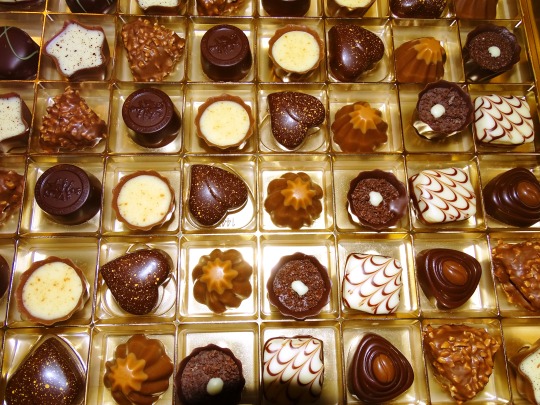
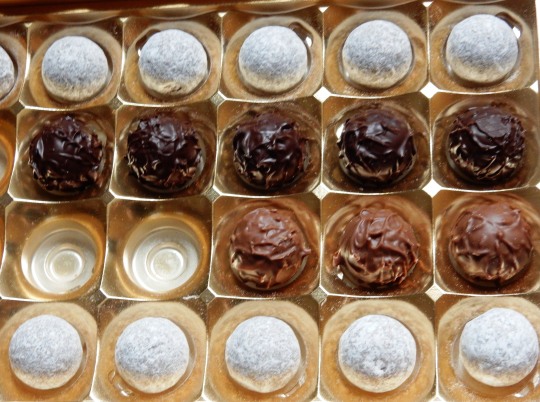


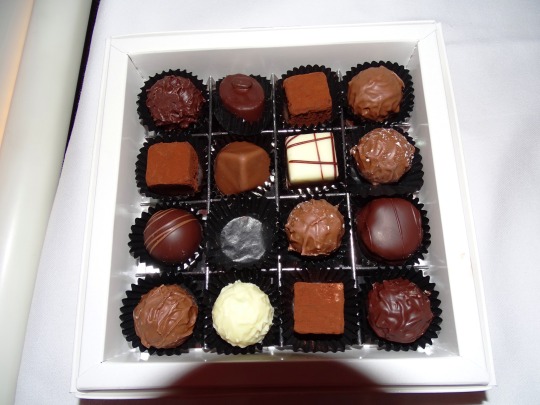

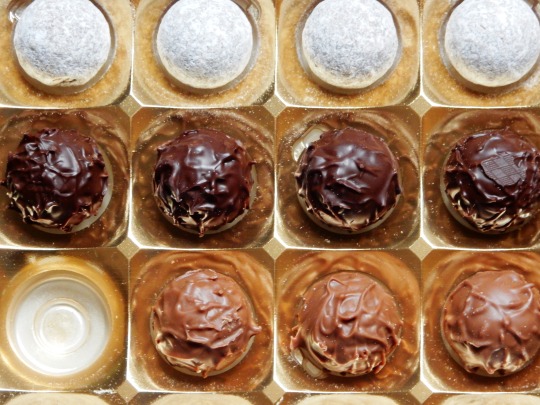







International Chocolate Day
While there may be a few people in the world who don’t like chocolate, for most of the world chocolate is considered to be a delicious treat. And for some people, chocolate may even be considered an obsession.
International Chocolate Day was created to learn about, celebrate and enjoy everything that has to do with chocolate!
History of International Chocolate Day
Chocolate plants have probably been on earth since the dawn of history. But it wasn’t until around 4000 years ago that the Olmec people of Mesoamerica (present day Mexico) began turning cocoa beans into a beverage. At the time, drinking chocolate was a rather rare and special delicacy that was used in cultural rituals as well as for medicinal purposes.
When the Aztecs and Mayans got involved with it years later, cocoa beans eventually were cultivated and used as valuable currency for trading. Mayans even referred to chocolate as a “drink from the gods”, and the Aztecs considered it to be an important way to prepare for war as well as using it as an aphrodisiac.
Around the 16th century, chocolate made its way to Europe, although the Spanish kept it a secret for quite some time. Eventually, “chocolate houses” (something like a pub but for chocolate) began popping up in Britain and the trend spread through Europe.
The invention of the chocolate press influenced chocolate making and made the possibility of solid chocolates more feasible. In addition, the Dutch process to make cocoa powder allowed chocolate to be more accessible to more people, other than just the rich or royals.
By the mid-to-late-1800s, chocolate companies began manufacturing chocolate bars in Europe. Nestle, J.S. Fry and Sons and Lindt companies were all started during this time. Later, other companies came along such as Hershey’s, Cadbury, Mars and more.
As the processes of making chocolate have been refined over the years and access to sugar and other ingredients has become easier, chocolate has become part of everyday life for many people.
Recipes that call for the ingredient might include chocolate candies, cakes, brownies, cookies, cupcakes and so much more. And it can be used in the form of cocoa powder or baking chocolate in dark, semi-sweet or milk chocolate versions.
International Chocolate Day is about paying heed to everything related to this delightful treat that is now part of cultures all over the world. Enjoy learning about and taking part in the celebration of this day!
International Chocolate Day Timeline
2000 BC Cacao beans used in Mesoamerica
Ancient Olmec people in what is modern-day Mexico turn the beans into a chocolate drink and use it medicinally.
600 AD Mayan people begin cultivating cocoa
Understanding the great value of this plant, the Mayans begin growing cocoa beans on farms.
15th Century Aztecs use cocoa as currency
So precious were these beans, the Aztec people found them a convenient and valuable way to secure trade.
1875 First milk chocolate hits the market
Daniel Peter introduces milk chocolate in Switzerland.
1894 Hershey Chocolate Company is started
One of the most famous American chocolate companies, Hershey gets its start in Pennsylvania.
How to Celebrate International Chocolate Day
A favorite day of the year for many people, International Chocolate Day is certainly one that deserves celebrating. Consider some of these ideas for participating in and enjoying this day:
Enjoy Eating Some Chocolate
Whether it’s milk chocolate, semi-sweet chocolate or dark chocolate, International Chocolate Day is the perfect time to enjoy taking part in this delicious treat. Grab a favorite type of chocolate bar, like Hershey’s, Nestle or Ghirardelli, or try out some new and special types of chocolate that are sourced from different parts of the world.
Another fun way to celebrate the day is to buy a huge box of chocolates and try out the different flavors. Whitman’s Samplers, Fannie May, Richart, Lindt and Godiva are just a few of the companies that make assorted boxes of chocolates. Read the list on the lid to find out what you are eating, or hide the list and make a guessing game out of finding out which flavor each chocolate is!
Host an International Chocolate Day Event
Whether it’s a setup in the breakroom with coworkers at the office or a party at home including neighbors and friends, International Chocolate Day is a great time to gather chocolate lovers together and pay heed to this worldwide sensation.
Featuring everything chocolate, this gathering can include creative snacks like a chocolate fountain, homemade chocolate brownies or chocolate ice cream sundaes. For activities, try a chocolate tasting table where guests can sample a variety of chocolates that are sourced from around the world. Perhaps include chocolates that contain higher or lower percentages of cocoa.
Enjoy Chocolate For All the Meals
Chocolate doesn’t have to be only for dessert! It can be used in savory meals as well. So, in honor of International Chocolate Day, in addition to having it for a snack or dessert, try including chocolate in meals for breakfast, lunch and dinner.
Chocolate for breakfast can be an easy inclusion. Chocolate yogurt, chocolate smoothies, or chocolate cherry muffins can be on the menu. If the chocolate included in breakfast is dark chocolate, it can even work in a healthy manner to help to burn body fat and decrease blood sugar levels throughout the day!
For lunch and dinner, savory meals can be created that include chocolate. Certain recipes for chili (specially Cincinnati style chili) include shavings of dark chocolate and cinnamon flavors and it’s served on top of pastas. Mole sauce, which is a traditional Mexican dish, is made with chocolate and spices and used on meat dishes, tortillas, or enchiladas.
Salads make a great light lunch and many salad recipes can be adjusted to incorporate some chocolate. Try a spinach pear salad with chocolate vinaigrette or a baby spinach and strawberry salad with vidalia onions and cacao nibs.
Bake Something with Chocolate
Of course, the easiest time to incorporate chocolate into eating is for dessert. Try whipping up a basic brownie recipe, baking some pre-made chocolate chip cookie dough, or preparing some easy no-bake chocolate, peanut butter and oat cookies without even having to turn the oven on. International Chocolate Day is a great time to enjoy baking with this versatile ingredient.
Share Chocolate with Friends
As long as you are cooking or baking, why not go ahead and share with someone special in celebration of the day? Or, for those who don’t feel like baking, feel free to pop over to a local bakery or grocery store! Box up some chocolate cupcakes to give to the neighbors, pass out some chocolate muffins at work or simply get a big chocolate bar and share it with the family!
International Chocolate Day FAQs
Can chocolate kill dogs?
Some properties in chocolate can be toxic. It may be poisonous to dogs depending on their size and how much they consume.
Does chocolate cause constipation?
Chocolate can slow down the digestive process and is one of the worst causes of constipation.
Did chocolate come from the New World?
Yes, chocolate originated in the New World and was brought back to Spain in the 16th century.
Does chocolate have caffeine?
Chocolate does have caffeine. The darker the chocolate is, the higher the caffeine content is.
Does chocolate cause acne?
While there is no evidence that chocolate causes acne, some people find anecdotal evidence that their skin condition is negatively impacted.
Source
#International Chocolate Day#original photography#food#snack#Chocolat Frey#Lindt CONNAISSEURS#Lindt & Sprüngli#Lindt TRUFFES#Sprüngli#truffles#Lindt PRALINÉS DU CONFISEUR#Swiss chocolate is the best#I only eat Swiss chocolate#InternationalChocolateDay#13 September#pralines#box of chocolate
2 notes
·
View notes